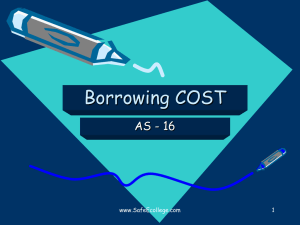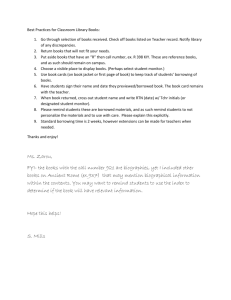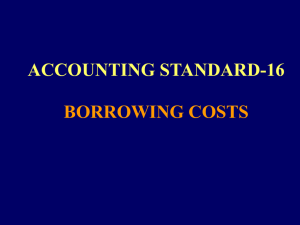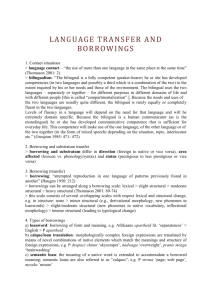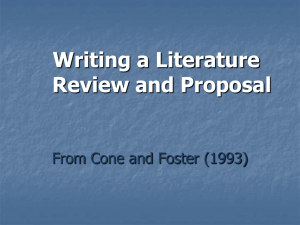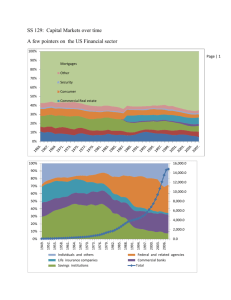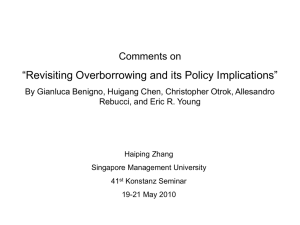PSAK NO. 26
advertisement
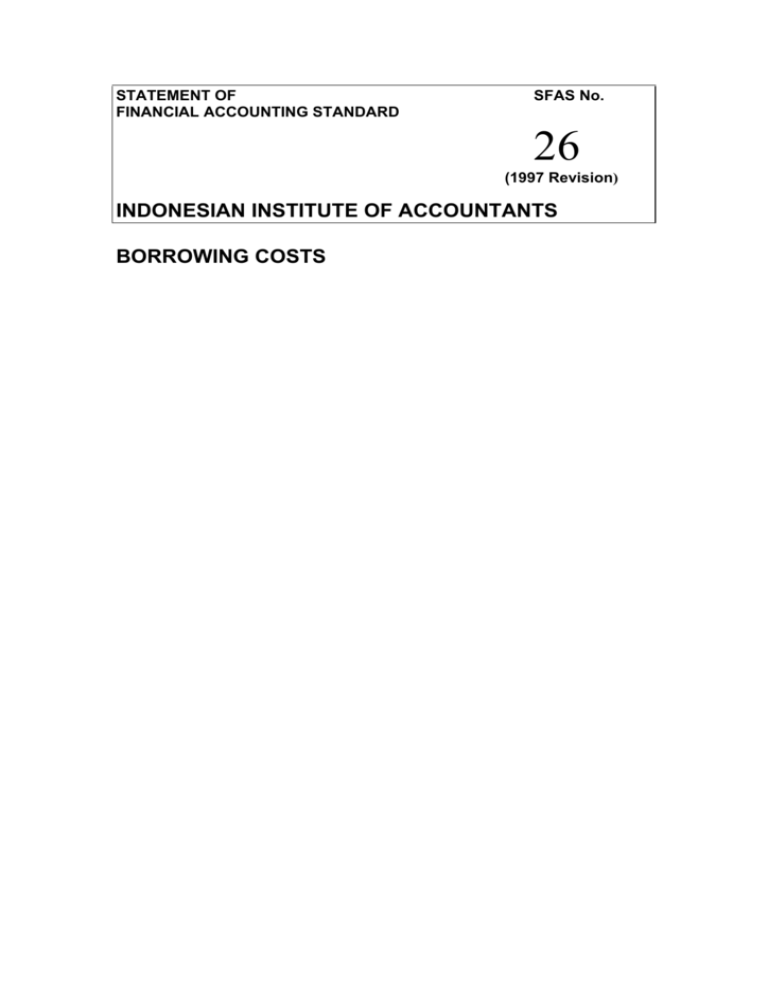
STATEMENT OF FINANCIAL ACCOUNTING STANDARD SFAS No. 26 (1997 Revision) INDONESIAN INSTITUTE OF ACCOUNTANTS BORROWING COSTS BORROWING COSTS_______________________________________ SFAS No. 26 Statement of Financial Accounting Standard (SFAS) No. 26 (1997 Revision), Borrowing Costs, was adopted by a meeting of the Indonesian Accounting Principles Committee on October 17, 1996, and was ratified by the Executive Committee of the Indonesian Institute of Accountants on January 14, 1997. As of the effective date of this Statement, the previous SFAS No. 26, Accounting for Interest During the Construction Period, has been superseded. Jakarta, January 14, 1997 Indonesian Accounting Principles Committee Drs. Jusuf Halim Dra. Istini T. Siddharta Drs. Mirza Mochtar, MBA Dr. Wahjudi Prakarsa Dr. Katjep K. Abdoelkadir Drs. Jan Hoesada, MM Drs. Hein G. Surjaatmadja Drs. Sobo Sitorus Drs. Timoty E. Marnandus, MBA Dra. Mirawati Sudjono, MSc Dr. Nur Indriantoro Drs. Rusdy Daryono Dra. Siti Ch. Fadjriah Drs. Osman Sitorus Drs. Jusuf Wibisana, MSc Dra. Yosefa Sayekti, MCom Drs. Heri Wahyu Setiyarso, MBA Chairman Vice Chairman Secretary Member Member Member Member Member Member Member Member Member Member Member Member Member Member BORROWING COSTS_______________________________________ SFAS No. 26 CONTENTS paragraphs INTRODUCTION................................................................................................ Objective................................................................................................. Scope....................................................................................................... Definitions............................................................................................... 01-05 01 02-04 05 EXPLANATION................................................................................................... Recognition............................................................................................. Capitalization of Borrowing Costs........................................................ Difference Between the Carrying Amount of the Qualifying Asset and Recoverable Amount............................................................................ Commencement of Capitalization.......................................................... Suspension of Capitalization................................................................. Cessation of Capitalization.................................................................... 06-25 09-10 11-15 STATEMENT OF FINANCIAL ACCOUNTING STANDARD NO. 26 (1997 REVISION), BORROWING COSTS.................................................... Disclosure........................................................................................... Transition............................................................................................ Effective Date..................................................................................... 16 17-19 20-21 22-25 26-37 35 36 37 BORROWING COSTS SFAS No. 26 INTRODUCTION Objective 01 The objective of this Statement is to prescribe the accounting treatment for borrowing costs. This Statement generally requires the immediate expensing of interest costs as incurred. However, borrowing costs which could be directly attributable to the acquisition, construction, or production of a qualifying asset should be capitalized. Scope 02 This Statement should be applied in accounting for borrowing costs. 03 This Statement supersedes PSAK No. 26, Accounting for Interest During the Construction Period, which has been effective since 1988. 04 This Statement does not address actual or imputed cost of equity. Definitions 05 The following terms used in this Statement are defined as follows: Borrowing costs are interest and other related costs incurred by an enterprise in connection with the borrowing of funds. Qualifying assets are assets that necessarily take a substantial period of time to get them ready for their intended use or sale. EXPLANATION 06 Borrowing costs includes the following: (a) Interest on borrowed funds, either short-term or long-term. (b) Amortization of discounts or premiums related to the borrowings. (c) Amortization of costs incurred in connection with obtaining the borrowing such as consultants’ fees, legal fees, commitment fees and the like. (d) Exchange differences arising from borrowings denominated in foreign currencies (as long as the exchange differences are adjustments to interest costs) or amortization of premiums related to contracts to hedge against borrowings denominated in foreign currencies. 1 BORROWING COSTS SFAS No. 26 07 Qualifying assets include qualifying inventory, manufacturing plants and power generation facilities. Assets that are ready for their intended use or sale at the acquisition date are not qualifying assets. 08 Qualifying inventory is defined as inventory that requires a substantial period of time to bring them to a saleable condition. A substantial period of time is defined as 12 months or more. Inventory which is ready for sale at the acquisition date is not a qualifying asset. Recognition 09 Borrowing costs should be recognized as an expense in the period in which they are incurred, except for borrowing costs that should be capitalized in accordance with paragraph 10. 10 Borrowings costs that are directly attributable to the acquisition, construction, or production of qualifying assets should be capitalized as part of the acquisition cost of the qualifying assets. The amount of borrowing costs capitalized should be determined in accordance with this Statement. Capitalization of Borrowing Costs 11 If borrowing costs can be directly attributable to a qualifying asset, it should be capitalized to that qualifying asset. If borrowing costs cannot be directly attributable to a qualifying asset, then capitalization of these costs should be determined in accordance with paragraph 15. 12 Under certain circumstances, it is difficult to identify the direct relationship between the particular borrowing and the acquisition of a qualifying asset, and to determine that a particular borrowing could otherwise have been avoided if the acquisition of a qualifying asset did not occur. For instance: if there is centralization of the financing function for all business activities. It can also be difficult if the Company obtains several debt instruments with varying interest rates. Under such circumstances, it is difficult to determine the total borrowing costs which are directly attributable to the acquisition of a qualifying asset and hence the exercise of judgment is required. 13 If the borrowing is specifically for the purpose of acquiring a qualifying asset, the total borrowing costs capitalized would comprise of all borrowing costs incurred on that borrowing during the period less any investment income earned on the unused proceeds from the borrowings. 14 The financing arrangements for the acquisition of a qualifying asset may require a company to receive the borrowed funds and pay borrowing costs before all or part of the borrowed funds are used for the acquisition of the qualifying asset. In 2 BORROWING COSTS SFAS No. 26 determining the amount of borrowing costs that are eligible for capitalization during the period, the borrowing costs are reduced by the investment income on the unused proceeds from the borrowing. 15 If borrowed funds were not specifically for the purpose of acquiring qualifying assets but were subsequently used to acquire qualifying assets, the amount of borrowing costs eligible for capitalization should be determined by applying a capitalization rate to the expenditures on those assets. The capitalization rate is calculated based on the weighted average of borrowing costs divided by total borrowings for the period (not including borrowings specifically for the purpose of obtaining qualifying assets). The amount of borrowings costs capitalized during a period should not exceed the total borrowing costs incurred during that period. Difference Between the Carrying Amount of the Qualifying Asset and Recoverable Amount 16 When the carrying amount or the expected ultimate cost of the qualifying asset exceeds its recoverable or net realizable value, the carrying amount should be written down in accordance with other Statement of Financial Accounting Standards. Commencement of Capitalization 17 Capitalization of borrowing costs as a part of the acquisition cost of an asset commences when: (a) Expenditures for the asset have been incurred; (b) Borrowing costs have been incurred; and (c) Activities that are necessary to get the asset ready for development or production are in progress. 18 Expenditures on qualifying assets consist of payments of cash, transfers of other assets, or the assumption of interest-bearing liabilities. The capitalization of borrowing costs is calculated proportionally based on total borrowing costs less investment income which is related to the qualifying asset. The average carrying amount of a qualifying asset during a period, including previously capitalized borrowing costs, is normally a reasonable approximation of the expenditures to which the capitalization rate is applied in that period. 19 The activities that are necessary to prepare the asset for its intended use or sale encompass more than physical construction of the asset. They include technical and administrative work prior to the commencement of physical construction, such as the activities associated with obtaining permits prior to the commencement of the physical construction. It is considered that no activities have taken place if the company does not engage in development or production efforts to change the condition of the asset. For 3 BORROWING COSTS SFAS No. 26 instance, borrowing costs incurred during the period in which land is being developed should be capitalized. However, if the company purchases land and does not conduct any activities, the borrowing costs should not capitalized. Suspension of Capitalization 20 Capitalization of borrowing costs should be suspended during extended periods in which acquisition, construction, or production activities are interrupted. 21 Borrowing costs may continue to be incurred during a period in which acquisition, construction or production activities are interrupted; however, the borrowing costs during this period should not be capitalized. Under certain circumstances, physical construction activities are interrupted when technical and administrative tasks are being carried out. Under these circumstances, capitalization of borrowing costs should not be suspended. Capitalization of borrowing costs is also not suspended when a temporary delay/interruption is required or necessary in the process of acquiring, constructing or producing the qualifying asset. For example, during the construction of a bridge, physical construction activities are temporarily interrupted due to high water levels. Under this situation, capitalization should not be suspended if such high water levels are common in that geographic location. Cessation of Capitalization 22 Capitalization of borrowing costs should cease when activities to acquire, construct or produce the qualifying asset are substantially complete. 23 An asset is normally ready for its intended use or sale when physical construction is complete, even though routine administrative activities may still be required. Under such circumstances, borrowing costs should not be capitalized. 24 When the construction of an asset can be completed in parts and each completed part is capable of being used while construction continues on other parts, capitalization of borrowing costs should apply only to the uncompleted parts. 25 In a business park comprising several buildings, each building can be considered individually as qualifying assets because the first completed building could be used, sold or rented in accordance with the intended purpose without depending on completion of the second building. On the contrary, for an industrial plant involving several stages of production processes, construction is not considered complete until the whole plant is complete. This is because the plant has to be completed before any part can be used. STATEMENT OF FINANCIAL ACCOUNTING STANDARD NUMBER 26 (1997 REVISION) 4 BORROWING COSTS SFAS No. 26 BORROWING COSTS Statement of Financial Accounting Standard No. 26 consists of paragraphs 26-37. This Statement should be read in the context of paragraphs 1-25. 26 The following terms used in this Statement are defined as follows: Borrowing costs are interest and other related costs incurred by an enterprise in connection with the borrowing of funds. Qualifying assets are assets that necessarily take a substantial period of time to get them ready for their intended use or sale. 27 Borrowing costs should be recognized as an expense in the period in which they are incurred, except for borrowing costs that should be capitalized in accordance with paragraph 28. 28 Borrowings costs that are directly attributable to the acquisition, construction, or production of qualifying assets should be capitalized as part of the acquisition cost of the qualifying assets. The amount of borrowing costs capitalized should be determined in accordance with this Statement. 29 If the borrowing is specifically for the purpose of acquiring a qualifying asset, the total borrowing costs capitalized would comprise of all borrowing costs incurred on that borrowing during the period less any investment income earned on the unused proceeds from the borrowings. 30 If borrowed funds were not specifically for the purpose of acquiring qualifying assets but were subsequently used to acquire qualifying assets, the amount of borrowing costs eligible for capitalization should be determined by applying a capitalization rate to the expenditures on those assets. The capitalization rate is calculated based on the weighted average of borrowing costs divided by total borrowings for the period (not including borrowings specifically for the purpose of obtaining qualifying assets). The amount of borrowings costs capitalized during a period should not exceed the total borrowing costs incurred during that period. 31 Capitalization of borrowing costs as a part of the acquisition cost of an asset commences when: (a) Expenditures for the asset have been incurred; (b) Borrowing costs have been incurred; and (c) Activities that are necessary to get the asset ready for development or production are in progress. 5 BORROWING COSTS SFAS No. 26 32 Capitalization of borrowing costs should be suspended during extended periods in which acquisition, construction, or production activities are interrupted. 33 Capitalization of borrowing costs should cease when activities to acquire, construct or produce the qualifying asset are substantially complete. 34 When the construction of an asset can be completed in parts and each completed part is capable of being used while construction continues on other parts, capitalization of borrowing costs should apply only to the uncompleted parts. Disclosure 35 The financial statements should disclose: (a) The accounting policy for borrowing costs; (b) The amount of borrowing costs capitalized during the period; and (c) The capitalization rate used. Transition 36 This Statement should be applied on a prospective basis. Prior years’ financial statements before the effective date of this Statement do not have to be restated. Effective Date 37 This Statement becomes effective for financial statements covering periods beginning on or after January 1, 1997. Earlier application is encouraged. 6
